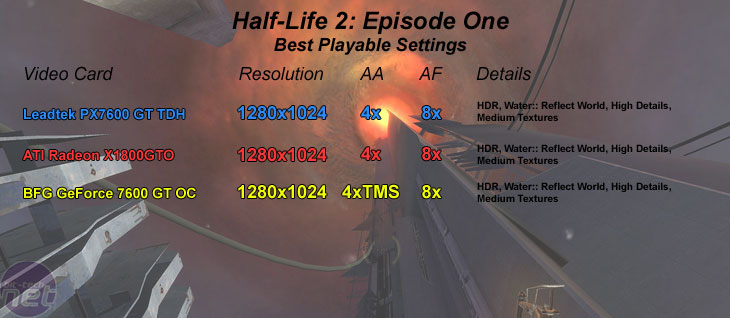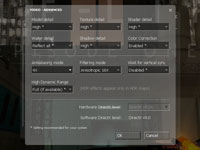Half-Life 2: Episode One
Publisher: Valve SoftwareHalf-Life 2: Episode One is the first in a series of episodes that extends the Half-Life 2 story far beyond where the original left off. Valve has implemented its high-dynamic range rendering and used it to great effect in Half-Life 2: Episode One. There are new higher-resolution textures, new facial animations and some AI improvements made in the new game too.
Anti-aliasing and anisotropic filtering were controlled from inside the game, and thus the drivers were left set to "Application Controlled". There are three options for the method of HDR used in this title. You can either disable HDR completely, make use of "Bloom" which is just what it says and less resource hungry in comparison to "Full" which, again is just what it says. It utilises a full dynamic range with the iris effect too.
We have written quite a bit about Half-Life 2: Lost Coast, Day of Defeat: Source, Episode One and how Valve have implemented HDR in to the Source Engine. You can check out the articles listed below for more information on The Lost Coast & Day of Defeat: Source.
- Half-Life 2: Lost Coast HDR overview
- Half-Life 2: Lost Coast hands on
- Half-Life 2: Lost Coast Benchmarks & Video
- Day of Defeat: Source
- Cinematic Effects in Source
- Liveblogging HL2: Episode One
We did a five minute manual run through from the Exit 17 level. It involves lots of HDR, lots of explosions and both indoor and outdoor scenes. The section we have used is typical of some of the more stressful areas in the game. Thankfully though, the game runs superbly on a wide range of hardware, while still looking absolutely stunning.


The BFG Tech GeForce 7600 GT OC was the fastest of the three video cards tested, as we were able to turn on transparency multisampling, while still delivering a smooth gaming experience. Performance on the Leadtek PX7600 GT TDH and the ATI Radeon X1800GTO was very similar - Leadtek's PX7600 GT had an average frame rate advantage, while the Radeon X1800GTO had a minimum frame rate advantage, thanks to its increased memory bandwidth.
We would call this one a draw between the Radeon X1800GTO and Leadtek PX7600 GT TDH, with the BFG Tech GeForce 7600 GT OC maintaining a slight performance lead. However, when it came to the noise made during gameplay, Leadtek's card came up trumps again.

MSI MPG Velox 100R Chassis Review
October 14 2021 | 15:04







Want to comment? Please log in.